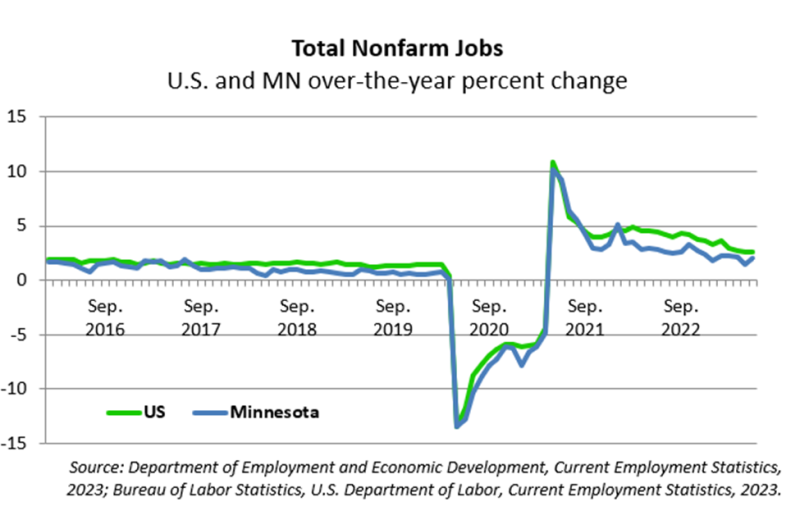By Nick Dobbins
October 2023
Employment in the Minneapolis-St. Paul-Bloomington MSA was down by 7,333 (0.4%) over the month in September. Eight of 10 published supersectors posted negative monthly growth, with the largest real and proportional declines coming in Leisure and Hospitality, which was down by 7,927 jobs or 3.9%. Large monthly declines are common in the supersector in September, as summer recreation tapers off heading into fall. The largest real and proportional movement overall came in Government, which added 17,650 jobs or 7.6%. All three levels of government added jobs, with Local Government employment up 12,123 (8.1%) and State Government up 5,498 (8.9%), with growth at both levels concentrated in educational services as students returned to schools.
Over the yea, the metro area added 32,927 jobs (1.7%), with seven of 10 published supersectors posting positive growth. Educational and Health Services added 16,398 jobs (4.8%) with growth coming entirely in Health Care and Social Assistance (up 16,622 or 5.6%). Leisure and Hospitality employment was up 14,766 (8.3%), and Government employers added 9,404 jobs (3.9%) with positive growth in every published level of government. The largest real job losses came in Professional and Business Services, which was off by 9,144 jobs (3%), while the largest proportional decline came in Financial Activities, which was down by 3.3% or 4,933 jobs.
The Duluth-Superior MSA added 676 jobs (0.5%) in September, outpacing the statewide 0.1% job loss. Growth was driven largely by Government employers, which added 1,995 jobs (8.7%). State Government added 1,290 jobs (19.9%), and Local added 709 (4.7%). The largest real and proportional declines came in Leisure and Hospitality, which was off by 651 (4.4%) as the labor market began its annual post-summer shift away from recreation industries. Trade, Transportation, and Utilities employment was down 267 (1.1%), with Retail Trade losing 295 jobs (1.9%).
Over the year Duluth-area employers added 982 jobs (0.7%), with five of 10 published supersectors posting positive growth. Other Services posted the highest proportional growth, adding 6.3% or 358 jobs. Government employers added 1,051 jobs (4.4%) with growth at all three levels. Trade, Transportation, and Utilities employment was up 654 (2.7%), with Retail Trade adding 580 jobs (4%). The largest real and proportional decline came in Mining, Logging, and Construction which lost 839 jobs or 7.5%.
The Rochester MSA lost 909 jobs (3.4%) over the month in September. This was the worst proportional over-the-month growth of any supersector. Nine of 10 published supersectors lost jobs on the month. Leisure and Hospitality had the largest declines, off by 491 jobs, or 4.3%. Manufacturing was off by 132 or 1.4%. Trade, Transportation, and Utilities was down 157 (0.9%) with losses primarily coming in Retail Trade (off 173 or 1.3%). The only supersector to add jobs was Educational and Health Services, which was up by 155 or 0.3%.
Over the year Rochester employers added 4,167 jobs or 3.4%. Educational and Health Services employment was up by 2,888 or 5.5%, the largest real and proportional growth of any supersector in the area. Trade, Transportation, and Utilities added 892 jobs or 5.3%, with Retail Trade up 916 or 7.8%. Manufacturing and Professional and Business Services each lost 130 jobs, down 1.3% and 1.9%, respectively.
Employment in the St. Cloud MSA was up by 436 or 0.4% in September. Nine of 10 published supersectors lost jobs on the month, but positive growth in Government employment (up 1,548 or 11.7%) countered all of the job losses. All three levels of Government added jobs. The largest real and proportional job losses came in Leisure and Hospitality, which was off by 292 or 3.5%.
Over the year St. Cloud area employers added 181 jobs (0.2%). It was the lowest proportional growth of any MSA primarily in Minnesota although stronger than the Fargo-Moorhead MSA where employment was up 0.1%. Manufacturing was up 433, or 2.9%, and Educational and Health Services was up 366 (1.7%). The largest real and proportional declines were in Professional and Business Services, which lost 500 jobs or 6.4%.
The Mankato-North Mankato MSA added 2,595 jobs or 4.5% over the month of September. It was the highest proportional growth of any supersector in the state. Government employment drove the growth, adding 1,233 jobs or 12%. Goods producers lost 2 jobs (0.0%), the only negative published growth in the area.
Over the year the Mankato-North Mankato area added 3,658 jobs (6.2%). This was the highest proportional annual growth of any supersector in the state, with positive growth in every published series. Government employers added 1,233 jobs (13.3%), and private sector employers added 2,335 (4.9%).
The Fargo-Moorhead MSA added 1,526 jobs (1%) over the month in September. Government employers drove the growth, adding 2,451 jobs (14%). Only three other published supersectors added jobs (Other Services, up 12, Financial Activities, up 45, and Information, up 2). The largest real and proportional job losses came in Mining, Logging, and Construction, which shed 402 jobs or 4%.
Over the year the Fargo-Moorhead MSA added 208 jobs or 0.1%. This was the worst proportional over-the-year growth of any MSA in the state. The largest real and proportional job losses came in Mining, Logging, and Construction (down 581 or 5.7%). Growth was strongest in Leisure and Hospitality (up 453 jobs or 3.1%) and Educational and Health Services (up 524 jobs or 1.8%).
The Grand Forks-East Grand Forks MSA added 990 jobs (1.9%) in September. Government employment drove the growth, adding 1,038 jobs (8.7%) with State Government up 616 (11.8%) and Local Government up 425 (7.5%). Mining, Logging, and Construction was down 2.1% (69 jobs) and Trade, Transportation, and Utilities was down 115 jobs (1.1%).
Over the year the Grand Forks-East Grand Forks MSA added 961 jobs (1.8%). Government employment was up 477 (3.8%), Professional and Business Services was up 174 (4.6%), and Trade, Transportation, and Utilities was up 233 (2.3%). Four supersectors posted negative growth, with each of them losing less than 100 jobs. Mining, Logging, and Construction shed 84 jobs or 2.6%.
